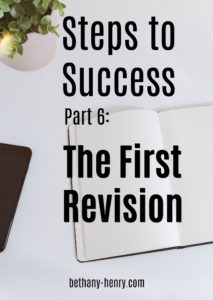Revising our writing can get a bad rap sometimes. After all, revisions are a lot of work! They can be confusing, hard, and none of us like to hear our work isn’t wonderful just the way it is. It would be nice if we could all write perfect stories the first time around. Unfortunately that’s not really how it works. As Hemingway said:
“The only kind of writing is rewriting.”
Clearly this whole rewriting thing is kinda important! It is a vital part of the writing process.
While sometimes we have this idea that “writing” is all about the first time we put words on a page, instead the majority of the work happens later on through revisions.
Revisions are where we cut out the boring scenes, describe the vague bits, and tie everything together. This process is crucial for honing our work and bringing it from good to great. (Or even from terrible to great if your first drafts look anything like mine 😉 )
This isn’t always an easy process! Sometimes I’m overwhelmed by revisions because I don’t even know where to start. Thankfully we’re not alone as we figure this all out. There is hope for us yet!
This post is Part 6 of the Steps to Success series designed to walk us through the process of writing a novel from beginning to end. As always, personal preferences and experiences differ. This guide is based in part on my own experiences as well as from authors I have worked with and/or learned from along the way.
Find steps 1-5 here:
- Getting Started (where we look at our goals for writing and find our starting point)
- Developing Content (where we dig a bit deeper into what story we want to tell)
- Creating an Outline (where we brainstorm the basic structure of our story)
- The First Draft (where we get our writing plans in place and start our story)
- Rest (where we set our writing aside to breathe)
Revisions don’t need to be scary.
After all, we’ve already come up with a concept for our story, we know what we want to say, and we’ve already put a draft down on paper. We have lots of material to work with!
Instead of being intimidated by the vague revision monster that just says “make it better” and leaves us to stress over how to actually *do* that, we can tackle our revisions like we’ve tackled every other part of writing. We can look our work over, break it into manageable pieces, make a plan, and find where we want to start. Revising is just another part of writing, there doesn’t need to be anything scary or mysterious about it.
Hopefully you’re entering these revisions after some time away from your draft (see Step 5: Rest) and are all excited to be working with your story again! So let’s just start right in. As always, everyone’s personal writing process will be different but this should give us a foundation to build on.

7 Basic Steps Of Revising
-
Reread our story
- To start with we need to jump back into our story. Some people like to take notes while they read, others will read the whole draft and jot down their thoughts at the end. Whichever process works best for you is fine, we just want to make sure we are writing down our thoughts and questions. A lot of things will probably jump out at us both good and bad. We want to take full advantage of this read through and take note of both what we like and what we don’t like about our story.
-
Remind ourselves of our goals
- We need to take a moment to remember why we started our project and what we want this story to be about. Rereading our draft can be fun but also possibly a bit confusing. It’s good to take time to center ourselves and remember what our original goals are.
-
Compare the story idea we started with to the story we have
- Rarely does the story we write match up perfectly with the story we’d envisioned writing. And that’s okay! What we want to do is compare the draft we’ve written with our original story concepts. Does the draft do a good job of embodying our concepts or did new themes and plots emerge? Again, it’s not a bad thing if our writing ended up going in a different direction than we initially imagined. Sometimes our best ideas come to us while we’re writing and sometimes we can’t tell whether or not an idea is a good one until we have it on paper. This is a time to evaluate what we have written.
-
Decide on a direction
- Once we’ve evaluated our draft we should have a decent idea of whether it matches up to what we planned on writing. If it matches up well and you like what you’ve got, that’s awesome! Keep up the great work.
- However, if our draft doesn’t look like how we originally envisioned it then we need to figure out where to go next. Maybe we want to stick with our original story concepts or maybe not. Often there are multiple good stories possible within a draft depending on how it’s revised. We could revise our story to center more on a character’s backstory and development or we could scrap the backstory and add more explosions to keep the plot moving.
Sometimes there isn’t a right or wrong direction to take a story in. Different genres, audiences, and story themes will all influence what a story looks like. What matters is that we choose the story that we want to tell.
Questions to ask ourselves are:- Does my core story match up with my writing goals?
- Do I like my story?
- What do I like or dislike about my story?
- Do I still like my original writing/story goals?
- Again there are not always “right” or “wrong” answers here. You’re deciding whether you want to revise your draft to remain true to your original ideas or if those concepts should be changed. This may be a simple decision or it could take some time. Take that time and make sure you feel comfortable with the feel of your story and the direction you want to take it in.
-
Evaluate what needs to be changed
- Now that you’ve confirmed which direction you want to take the story in it’s time to identify what parts of the story need to be changed to make it more like the story you want. There are several issues we want to make sure we are evaluating to make sure they are solid. You may have already made note of these things during your read through but things to double check are:
- Plot structure: Look for plot holes, moments that feel contrived or fake, boring sections, or anything that just doesn’t quite make sense.
- Character depth: Evaluate character’s motivations, continuity, likability, and distinctness.
- Setting: Check to make sure your setting is descriptive and has depth but that it isn’t overly confusing, wordy, or boring.
- Wordcount: Keep in mind whether you’re at a good length for your audience/genre or if you should be looking to either cut it down or need to add to the story.
- Note: Don’t worry about fixing these issues yet! For now just identify issues you think need changing. As we revise our story it will be helpful to have a list of items to change, research, fix, or think about further.
- Now that you’ve confirmed which direction you want to take the story in it’s time to identify what parts of the story need to be changed to make it more like the story you want. There are several issues we want to make sure we are evaluating to make sure they are solid. You may have already made note of these things during your read through but things to double check are:
-
Brainstorm changes
- Now it’s time to take our list of things to change and figure out how to fix them. Plot holes? Characters don’t make sense? We’re not sure if the setting is even there or if the entire story takes place in a bubble? It’s time to put on our thinking caps and dream up some solutions.
- We’re still not fixing the problems in our story quite yet (though go ahead and fix those typos you found if they’re driving you crazy). At this point we’re simply brainstorming how to change the things we want to change.
- Remember, we don’t want to shy away from making changes just because it will be hard! Sometimes writing is hard but we’ve made it this far and we’re not giving up now. A good question to ask is, will our story be stronger by making this change? If the answer is yes then we should probably suck it up and do the work to make the change.
- Note: In a way this brainstorming stage is a lot like coming up with the original idea for our story in the first place and it can be quite fun! Now’s our chance to add in that cool plot twist you thought of, research the obscure eating habits of ancient civilizations, or finally figure out your favorite character’s backstory.
- We should be using this time to move through each item on our list from earlier and sort out what needs to be changed to make our story stronger. Once we’ve figured out what needs to be changed in our story we’ll be well on our way to making those changes happen!
-
Make a revision plan
- Maybe you don’t get as excited about making plans as I do, and really that’s okay 😉 The main idea here is that we want to break up our list of changes into manageable pieces and figure out where we want to start.
Some ways of doing this are:- Break up our list of changes by chapter and go through them one by one
- Do multiple revisions of our draft, each time tacking a different issue such as character, plot, etc
- Make a list of changes and then just do them in whichever order you want
- We will all have different styles of revising and that’s great! However we go about making these changes, the important thing is that we’re moving forward and bringing our story closer to being the best it can be.
- Along with giving us a starting point, our revision plan should also include some sort of a timeline that we want to follow, ie: finish revising one chapter per week or work on revisions half an hour per day. (This is how we keep our goal measurable and time-bound.) It can be tempting to putter along on our revisions and fiddle with each comma and witty dialog exchange for days. However, it’s it’s important to keep our story moving forward! We can always go back and spend some more time on our witty dialog later 🙂
- Maybe you don’t get as excited about making plans as I do, and really that’s okay 😉 The main idea here is that we want to break up our list of changes into manageable pieces and figure out where we want to start.

The next step is to get started!
Feeling ready to look over your draft and figure out what comes next? Excited to get started on some revisions?
Sometimes once we get moving we find that the revisions aren’t nearly as much work as we thought they would be. Some writers even say that revising is their favorite part of writing. There can be a lot of fun and excitement especially in the brainstorming and rewriting process as we make our writing into something better than ever before.
Regardless, let’s not let fear of revisions win the day.
After all, we’re writers! We created these stories out of nothing. We can brainstorm plot solutions and entire new worlds as needed.
And then once we break our revisions down into steps it’s just a matter of putting in the work.
Revisions, here we come! We’ve got this 🙂
What about you- How do you feel about revising your writing? Have you found any good revision tips that work for you?




